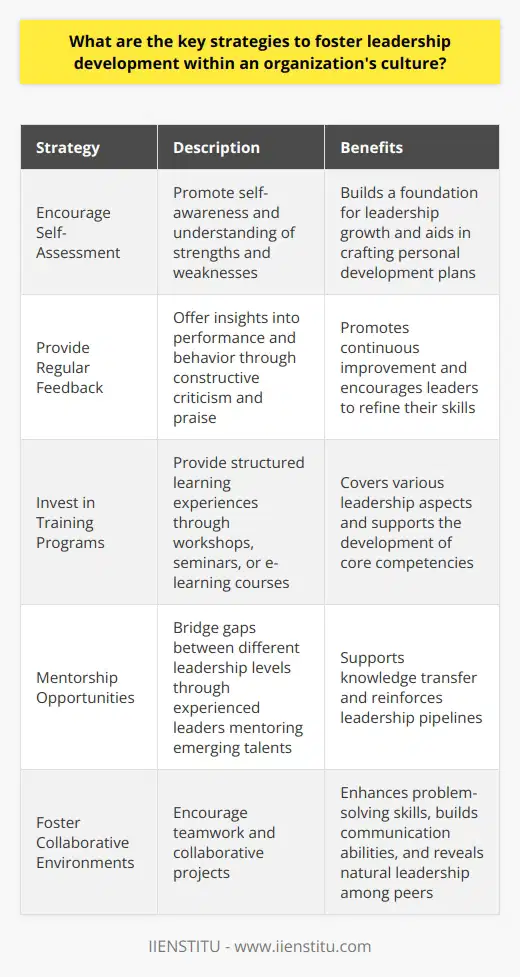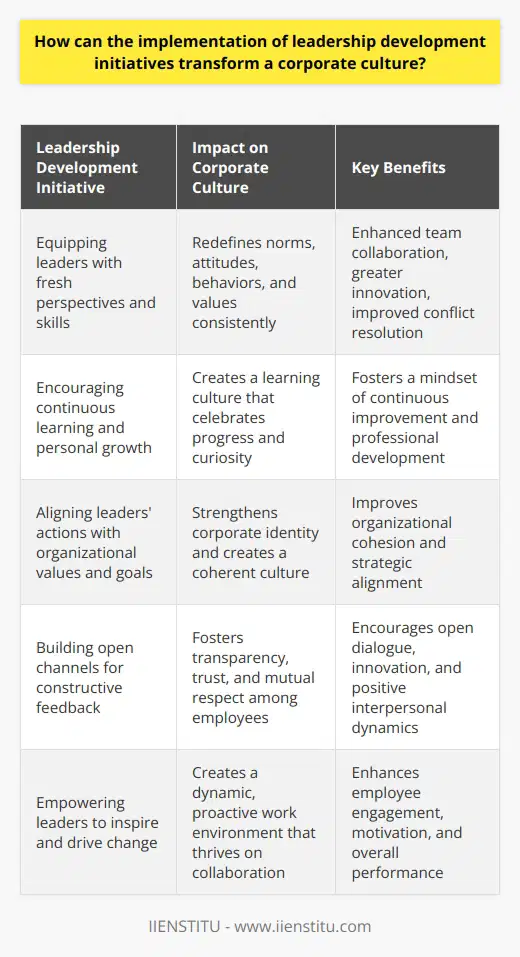
In the evolving landscape of modern business, the quest for effective leadership is more pressing than ever. At the intersection of innovation and human capital lies the crucial concept of leadership development—a cornerstone in harnessing the full potential of an organization's workforce. Leadership development is not merely a buzzword but a strategic process that cultivates essential skills within individuals, enabling them to navigate complex corporate waters with vision and agility.
By investing in leadership growth, companies don't just groom individuals for management roles; they ignite a transformation that permeates every level of their corporate culture. This article delves into the nuances of leadership development, its significance, and practical strategies for successful implementation within the corporate environment.
🔊 Ready for an auditory reading experience? Just click the 'Play' button right below this text and immerse yourself in our captivating audio version. Ideal for those who prefer listening to stories, or for times when you're multitasking. Engage with our content effortlessly - one simple click is all it takes to transform your reading into listening!
Understanding Leadership Development
Definition of Leadership Development
Leadership development is a systematic approach aimed at expanding the capability of individuals to perform in leadership roles within organizations. Leadership roles are often characterized by the ability to make important decisions, to influence others, and to guide a team or organization towards achieving its goals.
Quality leadership is often seen as a multiplier of organizational effectiveness, creating a ripple effect that can drive innovation, commitment, and performance in teams.
The Need to Develop Leadership Skills
The modern competitive landscape is constant only in its state of flux, which demands adaptive leaders who can steer their teams through dynamic changes and challenges. Leadership skills are not solely for the benefit of upper management; they are critical at every tier of a company structure.
Empowering employees with leadership qualities cultivates a proactive mindset and a sense of ownership, which are invaluable to the growth and sustainability of an enterprise.
Advantages of Having Good Leadership Skills in Professional Life
Good leadership skills are catalytic in transforming the average employee into a genuine asset for an enterprise. Strong leaders foster motivation, ensure better alignment with organizational goals, and can bridge the gap between individual tasks and company-wide strategic objectives.
Leadership skills also enhance personal career prospects, opening doors to more significant opportunities and challenges.
Effects of Poor Leadership on Team Performance
Conversely, inadequate leadership can result in low morale, high turnover rates, and an overall decline in productivity. Poor leadership creates a vacuum where confusion and dissatisfaction thrive, often leading to disjointed efforts and suboptimal outcomes.
It is, therefore, a business imperative to avoid such pitfalls by developing robust leaders who can uphold and propagate a company's values and objectives.
Essential Leadership Skills
Communication: Communication sits at the heart of leadership. The ability to convey ideas clearly, to listen actively, and to bridge understanding among diverse groups is what distinguishes a leader from the rest. An effective leader will translate complex concepts into accessible messages that resonate with the team's ethos, fostering a collaborative environment that encourages sharing and dialogue.
Explanation Why Communication is Crucial: Communication is the lifeblood of a team’s operations. It ensures that members are aligned with the goals and are working efficiently towards set objectives. Leaders must model excellent communication standards, including appropriate body language, tone, and clarity to inspire and instill confidence among team members.
Ways to Improve Communication Skills: To improve communication skills, leaders should engage in active listening, deliver feedback constructively, and cultivate the art of persuasive speaking. Workshops, hr online course, and online certification courses in communication can provide a formal structure for learning and improvement. At the heart of these learnings, real-world practice and conscious application of techniques are indispensable.
Conflict Resolution: The inevitability of conflict in a team dynamic makes conflict resolution skills not just beneficial, but essential for a leader. The skill to navigate differing viewpoints and negotiate solutions that satisfy all parties is a mark of effective leadership.
Importance of Being Able to Resolve Conflicts: Conflict resolution is critical because it affects the health and productivity of teams. Leaders who can resolve conflicts prevent divisions within the team and sustain a positive, productive environment. They embody diplomacy and promote an inclusive culture where concerns are addressed and resolved constructively.
Techniques for Effective Conflict Resolution: Successful conflict resolution often involves active listening, impartiality, and creativity in problem-solving. Formal training sessions and role-play exercises can be helpful in honing these skills. Additionally, leaders must be adept at identifying the underlying causes of conflicts and preemptively addressing them before they escalate.
Decision Making: Decision-making is the cornerstone of leadership action and determines the path that teams and organizations will follow. It entails analyzing information, projecting outcomes, and courageously selecting a course of action.
The Role of Decision Making in Leadership: Leaders are frequently called upon to make decisions that have far-reaching implications for their teams and organizations. This process often involves assessing risks, weighing pros and cons, and making judgments that align with strategic objectives. A resolute and informed decision-making process is emblematic of confident leadership.
Strategies to Improve Decision Making Skills: Improving decision-making skills may involve structured problem-solving methods, data analysis training, and developing a keen instinct for business implications. Immersive learning experiences, leveraging case studies, and scenario planning exercises can significantly enhance these skills. Again, hr online course offerings and online certification courses can provide foundational knowledge as well as advanced strategies for seasoned professionals.
Key Elements of Leadership Development Programs
Mentoring and Coaching: Mentoring and coaching are personalized methods of leadership development that complement each other. While mentoring is geared more towards guidance and advice from experienced leaders, coaching often focuses on specific development goals and performance improvements.
How These Techniques Help in Leadership Development: Mentoring helps in providing a broader perspective on leadership challenges and organizational dynamics, while coaching can address specific skill gaps or performance issues. Both offer invaluable insights that can accelerate a leader's growth trajectory by tapping into the wisdom and experience of others.
Actual Situations Where Mentoring and Coaching Have Been Beneficial: Many highly successful leaders credit their mentors and coaches for valuable insights and guidance, emphasizing the importance of these relationships. In practice, mentoring can help leaders understand how to navigate the politics of an organization, while coaching might help a leader learn how to more effectively communicate with and motivate their team.
Experiential Learning: Experiential learning involves learning through action, experience, and reflection. It is an interactive method that immerses learners in scenarios that reflect real-world challenges.
Explanation of What Experiential Learning is and How it Assists in the Development of Leaders: Experiential learning equips leaders with the ability not only to understand theoretical concepts but to apply them successfully. By engaging in simulated environments or role-playing exercises, leaders gain practical insights and develop their skills in a relatively risk-free setting.
Benefits of Incorporating Experiential Learning in Leadership Development Programs: The benefits of experiential learning include enhanced retention of knowledge, increased self-awareness, and improved critical thinking. This hands-on approach is particularly effective in solidifying leadership concepts because it fosters learning through tangible experience, allowing participants to test out solutions and learn from their outcomes.
Continuous Feedback: In the cycle of leadership development, feedback serves as a critical mechanism for growth and improvement. It is essential for leaders to not only provide meaningful feedback but to also actively seek and constructively utilize feedback for their development.
Importance of Feedback in Leadership Development: Feedback provides leaders with information on their performance and impact, enabling them to adjust their behaviors and strategies. It is an opportunity for continuous learning and practice, informing leaders about their strengths, areas for improvement, and influencing how they evolve their leadership style.
How to Effectively Give and Receive Feedback: To give effective feedback, leaders should be precise, empathetic, and focus on behaviors rather than personal traits. As recipients, leaders must remain open, non-defensive, and willing to integrate the feedback into their leadership approach. Creating a culture where feedback is regularly exchanged and valued is fundamental to a constructive learning environment.
Uncovering the Real Org Chart: Who Has the Power in Leadership?
Fundamentals Of Management: Pathway to Organizational Success
Implementation of Leadership Development Programs
Steps to Launch a Successful Leadership Development Program: Launching a successful leadership development program requires a strategic framework aligned with organizational goals. The program should be designed to target the specific needs of the organization and its leaders. It starts with the identification of key leadership competencies, followed by the development of tailored modules that address these competencies.
Monitoring Progress and Measuring Success
Importance of Quantifiable Results: To validate the effectiveness of a leadership development program, it is imperative to monitor participants’ progress and measure results. Quantifiable outcomes not only demonstrate the return on investment but also guide the fine-tuning of the program for future cohorts.
Evaluating the Effectiveness of the Program: The effectiveness of the program can be gauged through a variety of assessing tools such as 360-degree feedback, performance metrics, and employee engagement scores. It's vital to establish benchmarks and continuously track development to ensure that the program evolves in line with the changing needs of the organization and its leaders.
Case Studies of Successful Leadership Development
Case Study 1: A Company That Successfully Implemented a Leadership Development Program
A notable case of successful leadership development is that of a multinational corporation that implemented a comprehensive program focusing on cross-cultural management and strategic leadership. This led to increased agility, innovation, and a substantial improvement in global operational performance.
Case Study 2: How Leaders Have Grown Due to Leadership Development Programs
Another case study, from a rapidly scaling technology firm, showcases the individual growth of leaders who underwent intensive coaching and experiential learning modules. The result was a more cohesive leadership team, aligned with the company's disruptive ethos and equipped to drive exponential growth.
Recap of the Importance and Benefits of Leadership Development
Leadership development is an investment that pays substantial dividends to the individual and the organization. The systematic cultivation of leadership attributes drives business success, fosters a competent workforce, and establishes a dynamic corporate culture that can withstand the tests of a volatile business environment.
Encouragement for Individuals and Organizations to Invest in Leadership Development Programs
The journey of leadership development offers a lifetime of learning and growth. Individuals thirsting for growth and organizations striving for excellence are encouraged to embark on this track, fostering the next generation of dynamic leaders. Whether it is through online certification courses, experiential learning, or coaching, leadership development ensures that both leaders and organizations are primed to meet the future with confidence and skill.
Frequently Asked Questions
What are the key strategies to foster leadership development within an organization's culture?
Leadership Development in Organizational Culture
Developing leaders within an organization requires targeted strategies. These strategies foster growth and potential in employees. They shape the future of organizational leadership.
Encourage Self-Assessment
Self-awareness builds a foundation for leadership. It supports the growth of core competencies. Leaders must understand their strengths and weaknesses. This understanding aids in crafting personal development plans. These plans should align with organizational goals.
Provide Regular Feedback
Feedback promotes continuous improvement. It offers insights into performance and behavior. Constructive criticism encourages leaders to refine their skills. Praise reinforces positive actions. Both types of feedback are crucial.
Invest in Training Programs
Dedicated training programs are invaluable. They provide structured learning experiences. Programs might include workshops, seminars, or e-learning courses. These resources should cover various leadership aspects. Subjects can range from conflict resolution to strategic planning.
Mentorship Opportunities
Mentorship bridges gaps between different leadership levels. Experienced leaders mentor emerging talents. These relationships support knowledge transfer. They also reinforce leadership pipelines.
Empower Employees
Employee empowerment is key. It provides a sense of ownership. This autonomy encourages accountability. Leaders emerge when they feel their decisions matter.
Foster Collaborative Environments
Teamwork enhances problem-solving skills. It also builds communication abilities. Collaborative projects can show natural leadership among peers.
Recognize and Reward Leadership Behaviors
Acknowledgement motivates employees. It signals to others that leadership matters. Rewards for leadership behavior could vary. They might include promotions or public recognition.
Create a Culture of Accountability
Accountability ensures leaders take responsibility. It sets examples for future leaders. Accountability comes with transparency. Failures and successes are both opportunities for learning.
Support Work-Life Balance
Burnout hinders leadership development. A healthy work-life balance prevents burnout. It allows time for rest and rejuvenation. This balance is crucial for long-term leadership sustainability.
Diversify Leadership Experiences
Diverse experiences challenge leaders. They foster adaptability and innovation. Rotational assignments or cross-functional projects can help. They allow leaders to experience different facets of the organization.
Summary
Effective leadership development integrates into an organization's culture. It involves self-assessment, regular feedback, and training. Mentorship, employee empowerment, and team collaboration are crucial. Recognizing leadership, ensuring accountability, promoting balance, and providing diverse experiences are essential strategies. These efforts create a strong leadership culture. This culture ensures the growth and emergence of new leaders.

How can the implementation of leadership development initiatives transform a corporate culture?
Leadership Development and Corporate Culture Transformation
Leadership development initiatives stand at the forefront of organizational transformation. They imbue leaders with fresh perspectives. Effective leadership redefines corporate culture norms. It shapes attitudes, behaviors, and values consistently. This metamorphosis hinges on strategically implemented leadership programs.
The Catalyst of Leadership Development
Leadership development serves as a catalyst for change. It equips leaders with key skills. Communication, team building, and decision-making improve. This evolution starts at the individual level. Gradually, it permeates the entire organization. Leaders influence peers and subordinates alike. Their behaviors set a new performance standard.
Key Benefits of Leadership Initiatives
Core benefits emerge from leadership development. Organizations can expect:
- Enhanced team collaboration
- Greater innovation
- Improved conflict resolution
Each element propels corporate culture onward. Leaders learn to foster inclusivity and respect. Diverse opinions gain attention and value. Employee voices matter. This signals a culture of empowerment.
Fostering a Culture of Continuous Learning
Leadership programs encourage continuous learning. Leaders become learners. Their quest for knowledge proves relentless. This mindset trickles down. Employees adopt a similar stance. They seek personal and professional growth. The result: a learning culture. It celebrates progress and curiosity. It denounces stagnancy.
Aligning Values with Organizational Goals
Through development, leaders internalize organizational values. They align their actions accordingly. Their example speaks volumes. Employees notice. They emulate these values. Gradually, a coherent culture emerges. It aligns with the organization's strategic goals. This cohesion strengthens corporate identity.
Building a Feedback-Rich Environment
Open channels for feedback reflect well-developed leadership. They create a feedback-rich environment. Leaders learn to give and receive constructive criticism. This fosters transparency and trust. Mutual respect becomes a norm. It redefines interpersonal dynamics. It encourages open dialogue and innovation.
The Ripple Effect of Empowered Leadership
Leadership development has a ripple effect. It starts with the leaders. It moves to teams, departments, and the organization. Empowered leaders inspire empowered employees. This empowerment redefines corporate culture. It creates a dynamic, proactive work environment.
Conclusion: A Transformation Journey
Implementing leadership development turns a new page. It sets a firm foundation for a positive corporate culture. Leaders lead by example. They drive change. Their growth encourages others to follow suit. Together, they create a transformed corporate culture. It thrives on collaboration, continuous learning, and mutual respect.

What are the challenges faced during the integration of leadership development strategies within an established corporate culture?
Leadership Development Integration Challenges
Establishing Alignment
Organizations embark on integrating leadership development strategies to enhance capabilities and adapt to change. However, achieving effective integration with an established corporate culture poses significant challenges. Leadership development must align with the core values and strategic goals of an organization. This alignment proves challenging when old and new concepts clash. Cultural resilience may resist new strategies. Hence, existing mindsets present the first hurdle.
Overcoming Resistance
Resistance to change stands as a critical barrier. Employees often cling to known practices. They view new strategies with suspicion. This resistance can stem from fear of the unknown. Leaders must address these fears head-on. Transparency plays a key role here. It helps build trust and reduce resistance.
Bridging the Gap
Communication gaps also present obstacles. A clear understanding of the reasons behind leadership development strategies is essential. Without this understanding, employees may lack the commitment needed for successful implementation. Leaders must convey the benefits effectively. Again, this requires clear, consistent communication.
Ensuring Relevance
Ensuring the relevance of leadership development programs is another challenge. Each company has unique needs. Leaders must tailor strategies to meet these needs. One-size-fits-all programs rarely work. Relevance ensures engagement and paves the way for successful integration.
Adapting to Learning Styles
Attention to diverse learning styles is necessary. Varied instructional methods cater to this diversity. Leaders must support a range of training activities. These include mentorship, workshops, and experiential learning. Inclusion of multiple learning methods supports wider acceptance.
Maintaining Momentum
Initial enthusiasm for leadership development may wane. Long-term investment and reinforcement are vital to maintain momentum. Sustained support from top management is crucial. This includes allocating resources for ongoing development initiatives.
Measuring Impact
Measuring the impact of leadership development is complex. Determination of clear metrics to gauge effectiveness poses a challenge. Without metrics, it proves difficult to showcase the value and create a case for continuity.
Encountering Generational Differences
Workforce generational differences may impact strategy integration. Different age groups have varying expectations and learning preferences. Leaders must understand and address these differences to harmonize efforts.
Navigating Global Differences
For global companies, cultural differences across geographies complicate integration. Leadership development must respect and adapt to these nuances. Sensitivities around language, values, and business practices must guide strategy implementation.
Building Continuous Learning Cultures
Shifting to a culture of continuous learning requires commitment. Embedding this culture takes time and considerable effort. Leaders must serve as role models for continuous learning. This fosters a supportive environment for integration.
Conclusion
Integrating leadership development strategies within existing corporate cultures is indeed challenging. Leaders must navigate through resistance, communication gaps, and diverse learning needs. Alignment, relevance, and adaptability emerge as leading factors to overcome these hurdles. It demands continuous effort, but the outcomes can redefine an organization's potential.



